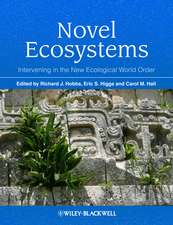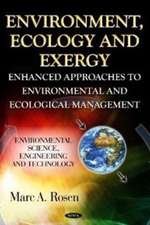Urban Wildlife Conservation: Theory and Practice
Editat de Robert A. McCleery, Christopher E. Moorman, M. Nils Petersonen Limba Engleză Hardback – 11 noi 2014
This growing interest in urban wildlife has inspired many studies on the subject that have yet to be synthesized in a cohesive narrative. Urban Wildlife: Theory and Practice fills this void by synthesizing the latest ecological and social knowledge in the subject area into an interdisciplinary and practical text. This volume provides a foundation for the future growth and understanding of urban wildlife ecology and management by:
• Clearly defining th
e concepts used to study and describe urban wildlife, • Offering a cohesive understanding of the coupled natural and social drivers that shape urban wildlife ecology,
• Presenting the patterns and processes of wildlife response to an urbanizing world and explaining the mechanisms behind them and
• Proposing means to create physical and social environments that are mutually beneficial for both humans and wildlife.
| Toate formatele și edițiile | Preț | Express |
|---|---|---|
| Paperback (1) | 796.85 lei 6-8 săpt. | |
| Springer Us – 10 sep 2016 | 796.85 lei 6-8 săpt. | |
| Hardback (1) | 973.42 lei 6-8 săpt. | |
| Springer Us – 11 noi 2014 | 973.42 lei 6-8 săpt. |
Preț: 973.42 lei
Preț vechi: 1187.10 lei
-18% Nou
Puncte Express: 1460
Preț estimativ în valută:
186.26€ • 194.100$ • 154.12£
186.26€ • 194.100$ • 154.12£
Carte tipărită la comandă
Livrare economică 05-19 aprilie
Preluare comenzi: 021 569.72.76
Specificații
ISBN-13: 9781489974990
ISBN-10: 1489974997
Pagini: 420
Ilustrații: XI, 406 p. 45 illus., 29 illus. in color.
Dimensiuni: 155 x 235 x 28 mm
Greutate: 7.51 kg
Ediția:2014
Editura: Springer Us
Colecția Springer
Locul publicării:New York, NY, United States
ISBN-10: 1489974997
Pagini: 420
Ilustrații: XI, 406 p. 45 illus., 29 illus. in color.
Dimensiuni: 155 x 235 x 28 mm
Greutate: 7.51 kg
Ediția:2014
Editura: Springer Us
Colecția Springer
Locul publicării:New York, NY, United States
Public țintă
GraduateCuprins
1. Introduction.- 2. History of Urban Wildlife Science.- 3. Urban Wildlife Science in Coupled Human-Natural Systems.- 4. Abiotic Drivers of Ecological Structure and Function in Urban Systems.- 5. Drivers of Vegetation Species Diversity and Composition in Urban Ecosystems.- 6. The Urban Ecosystem: Social Drivers.- 7. Wildlife Responses to Urbanization: Patterns of Diversity and Community Structure in Built Environments.- 8. Wildlife Population Dynamics in Urban Landscapes.- 9. Urban Wildlife Behavior.- 10. Infectious Disease and Contaminants in Urban Wildlife: Unseen and Often Overlooked Threats.- 11. Urban Wildlife Communication and Negotiation.- 12. Integrating Wildlife Conservation into Urban Planning.- 13. Conservation Development: Designing and Managing Residential Landscapes for Wildlife.- 14. Managing Urban Wildlife Habitat at the Local Scale.- 15. Wildlife Friendly Roads: The Impacts of Roads on Wildlife in Urban Areas and Potential Remedies.- 16. Managing Aquatic Environments for Wildlife in Urban Areas.- 17. Wildlife Damage Management in the Urban Landscape.
Recenzii
“This book compiles some 30 years of literature on wildlife in urban areas, including such aspects as the impacts of dense human populations, buildings, and concentrations of food and water. It also considers the social, economic, and political factors relevant to interactions between wildlife and humans. … This valuable, informative book should be on the reference shelves of wildlife biologists and urban planners as well as students in these areas. Summing Up: Recommended. Upper-division undergraduates through professionals/practitioners.” (R. L. Smith, Choice, Vol. 52 (11), July, 2015)
Notă biografică
Robert (Bob) McCleery is an Assistant Professor in the department of Wildlife Ecology and Conservation Biology at the University of Florida. His research focuses include understanding how wildlife responds to anthropogenic changes to their environment and finding ways to maintain wildlife communities and populations that foster healthy ecosystems. Much of Bob’s work has been centered on mammalian conservation in urbanizing and agricultural landscapes. Bob received his B.S. from Cornell University and M.S. and Ph.D. degrees from Texas A&M University.
Nils Peterson is an Associate Professor of Fisheries, Wildlife, and Conservation Biology at North Carolina State University. His research focuses on unravelling the drivers of environmental behavior, using environmental education, conservation development, environmental conflict and environmental policy-making as natural experiments to test hypotheses. Much of this research is summarized in his recent book The Housing Bomb. Nils received his B.S. and M.S. degrees from Texas A&M University and his Ph.D. from Michigan State University.
Chris Moorman is Professor and Coordinator of the Fisheries, Wildlife and Conservation Biology Program at North Carolina State University (NCSU). His research focuses on global change and wildlife with emphasis on understanding the effects of human-induced landscape change on wildlife habitat. Chris developed the course Urban Wildlife Management at NCSU, published a four-
part extension publication series on backyard and urban wildlife management and led collaborative efforts to create the Going Native website, an interactive resource for those interested in landscaping for wildlife with native plants. Chris received his B.S. and M.S. degrees from the University of Georgia and his Ph.D. from Clemson University.
Nils Peterson is an Associate Professor of Fisheries, Wildlife, and Conservation Biology at North Carolina State University. His research focuses on unravelling the drivers of environmental behavior, using environmental education, conservation development, environmental conflict and environmental policy-making as natural experiments to test hypotheses. Much of this research is summarized in his recent book The Housing Bomb. Nils received his B.S. and M.S. degrees from Texas A&M University and his Ph.D. from Michigan State University.
Chris Moorman is Professor and Coordinator of the Fisheries, Wildlife and Conservation Biology Program at North Carolina State University (NCSU). His research focuses on global change and wildlife with emphasis on understanding the effects of human-induced landscape change on wildlife habitat. Chris developed the course Urban Wildlife Management at NCSU, published a four-
part extension publication series on backyard and urban wildlife management and led collaborative efforts to create the Going Native website, an interactive resource for those interested in landscaping for wildlife with native plants. Chris received his B.S. and M.S. degrees from the University of Georgia and his Ph.D. from Clemson University.
Textul de pe ultima copertă
In the past, wildlife living in urban areas was ignored by wildlife professionals
and urban planners because cities were perceived as places for people and not
for wild animals. Paradoxically, though, many species of wildlife thrive in these
built environments. Interactions between humans and wildlife are more frequent
in urban areas than any other place on earth, and these interactions impact
human health, safety, and welfare in both positive and negative ways. Although
urban wild animals control pest species, pollinate plants, and are fun to watch, they
also damage property, spread disease, and even attack people and pets. In
urban areas, the combination of dense human populations, buildings,
impermeable surfaces, introduced vegetation, and high concentrations of food,
water, and pollution alter wildlife populations and communities in ways unseen
in more natural environments. For these ecological and practical reasons,
researchers and managers have shown a growing interest in urban wildlife
ecology and management.
This growing interest in urban wildlife has inspired many studies on the subject
that have yet to be synthesized in a cohesive narrative. Urban Wildlife: Theory
and Practice fills this void by synthesizing the latest ecological and social
knowledge in the subject area into an interdisciplinary and practical text. This
volume provides a found
ation for the future growth and understanding of urban wildlife ecology and management by:
• Clearly defining the concepts used to study and describe urban wildlife
• Offering a cohesive understanding of the coupled natural and social
drivers that shape urban wildlife ecology
• Presenting the patterns and processes of wildlife response to an
urbanizing world and explaining the mechanisms behind them, and
• Proposing means to create physical and social environments that are
mutually beneficial for both humans and wildlife.
and urban planners because cities were perceived as places for people and not
for wild animals. Paradoxically, though, many species of wildlife thrive in these
built environments. Interactions between humans and wildlife are more frequent
in urban areas than any other place on earth, and these interactions impact
human health, safety, and welfare in both positive and negative ways. Although
urban wild animals control pest species, pollinate plants, and are fun to watch, they
also damage property, spread disease, and even attack people and pets. In
urban areas, the combination of dense human populations, buildings,
impermeable surfaces, introduced vegetation, and high concentrations of food,
water, and pollution alter wildlife populations and communities in ways unseen
in more natural environments. For these ecological and practical reasons,
researchers and managers have shown a growing interest in urban wildlife
ecology and management.
This growing interest in urban wildlife has inspired many studies on the subject
that have yet to be synthesized in a cohesive narrative. Urban Wildlife: Theory
and Practice fills this void by synthesizing the latest ecological and social
knowledge in the subject area into an interdisciplinary and practical text. This
volume provides a found
ation for the future growth and understanding of urban wildlife ecology and management by:
• Clearly defining the concepts used to study and describe urban wildlife
• Offering a cohesive understanding of the coupled natural and social
drivers that shape urban wildlife ecology
• Presenting the patterns and processes of wildlife response to an
urbanizing world and explaining the mechanisms behind them, and
• Proposing means to create physical and social environments that are
mutually beneficial for both humans and wildlife.
Caracteristici
Emphasizes specific practices that can be used to create built environments that are wildlife friendly Focuses on mechanisms for the patterns and processes of wildlife ecology in urban environments In addition to human dimensions, the book will cover ecological theory, the behavior and physiology of urban wildlife and the planning and management of wildlife friendly developments Includes supplementary material: sn.pub/extras












